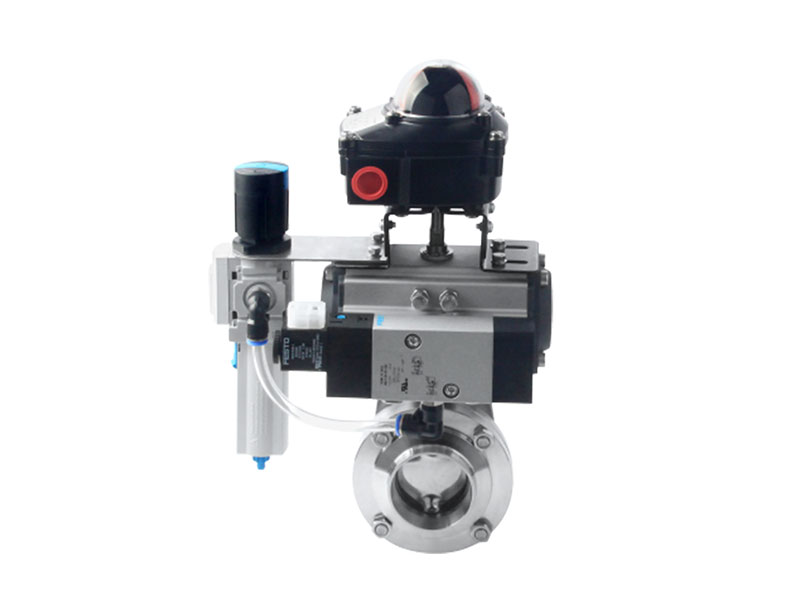 03 Tue 2024
03 Tue 2024
In the food, beverage, pharmaceutical and other industries, sanitary valves play a vital role to ensure that the flow of fluids in the pipeline system will not be contaminated. Among the many sanitary valves, sanitary pneumatic butterfly valves have become the first choice for many automated production lines due to their efficient and precise control capabilities. This article will explore the working principle, advantages and application scenarios of sanitary pneumatic butterfly valves in depth to help industry professionals better understand their importance.
Pneumatic butterfly valves consist of two main parts: the butterfly valve body and the pneumatic actuator. The valve body is usually made of sanitary stainless steel to ensure corrosion resistance and easy cleaning. The pneumatic actuator drives the valve to open and close through compressed air. The working principle of the pneumatic butterfly valve is very simple. The pressure is applied through the pneumatic system to push the valve stem to drive the butterfly plate to rotate, thereby controlling the flow of fluid in the pipeline.
In the pipeline system, the pneumatic butterfly valve achieves precise flow control by adjusting the air source. Usually, the opening angle of the pneumatic butterfly valve can be finely adjusted by adjusting the pressure and flow of the air source. Therefore, pneumatic butterfly valves can not only achieve precise fluid control, but also improve the degree of automation of the system.

Automated control
Pneumatic butterfly valves achieve automated operation through pneumatic control, which is essential for modern production lines. Especially in large-scale production environments, manual operation cannot meet the requirements of efficient flow control and reaction speed. Pneumatic butterfly valves can not only reduce manual intervention, but also improve production efficiency.
Hygiene and aseptic
Sanitary pneumatic butterfly valves are designed for high-standard hygienic requirements. The valve body adopts a dead-angle-free structure, which reduces the breeding space for bacteria, mold and other microorganisms. This is especially important for the food and pharmaceutical industries, because the sterility of the product is directly related to the quality and safety of production.
Strong corrosion resistance
Pneumatic butterfly valves generally use corrosion-resistant and high-temperature resistant materials such as stainless steel and polytetrafluoroethylene (PTFE), which can resist the corrosion of chemical substances and can operate stably in harsh environments. This makes pneumatic butterfly valves widely used in chemical, food and other industries.
Efficient and precise flow control
Since the pneumatic system can precisely adjust the degree of opening and closing of the valve, the sanitary pneumatic butterfly valve can provide a high degree of flexibility in flow regulation. This is essential for industries that require precise control of flow and pressure, such as pharmaceutical, brewing and dairy production.
Easy installation and maintenance
The design of sanitary pneumatic butterfly valves is usually considered for the convenience of installation and maintenance. Its simple structure and standardized accessories can be installed quickly and reduce system downtime. At the same time, regular cleaning and maintenance are relatively simple, ensuring long-term reliability and durability.
Food and beverage industry
Sanitary pneumatic butterfly valves are widely used in food and beverage production lines, especially in situations where strict hygiene standards are required, such as dairy products, beer brewing, beverage production, etc. In these industries, pneumatic butterfly valves can not only effectively control the flow, but also ensure the sterility of the system to avoid cross contamination.
Pharmaceutical industry
In the pharmaceutical industry, product purity and sterility are crucial. Sanitary pneumatic butterfly valves can help production lines maintain high standards of hygiene requirements, ensure that fluids are free of contamination in pipelines, and provide precise flow control to ensure the efficiency and consistency of drug production.
Chemical Industry
In the production process of some chemicals, pneumatic butterfly valves can withstand high temperatures and corrosive fluids to ensure the stability and safety of the production process. Especially in chemical plants that require automated control, pneumatic butterfly valves can provide efficient flow regulation and reduce the risk of human operation.
Water Treatment Industry
Sanitary pneumatic butterfly valves also have important applications in the water treatment industry, especially when treating drinking water and wastewater. Through precise flow control, pneumatic butterfly valves can effectively manage the flow of water and ensure the efficient operation of water treatment systems.
Sanitary pneumatic butterfly valves have been widely used in many industries for their advantages of automation, hygiene, corrosion resistance and efficient flow control. With the popularization of automated production lines, the role of pneumatic butterfly valves will become increasingly important. For production managers, understanding the working principle and advantages of pneumatic butterfly valves can not only improve production efficiency, but also ensure product quality and the safety of the production environment.
How to choose sanitary butterfly valves suitable for the food industry?
The Advantages of Manual Regular Butterfly Valves in Industrial Applications